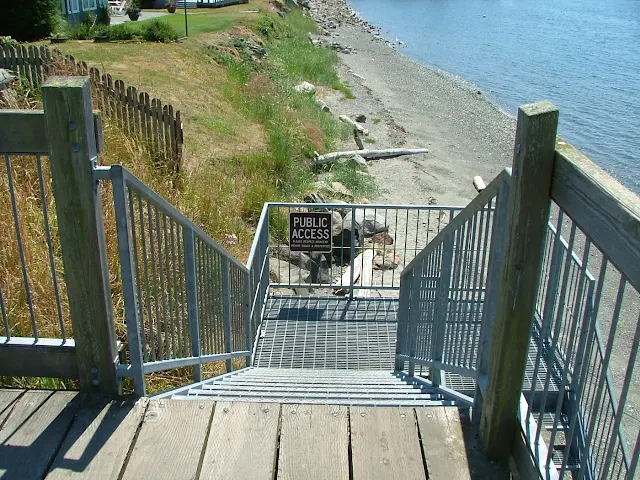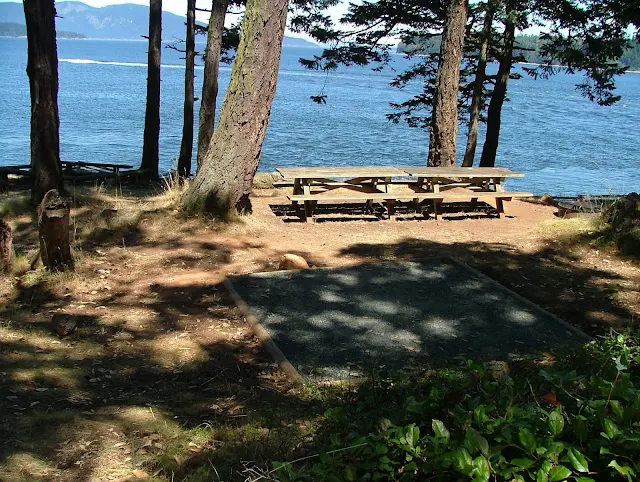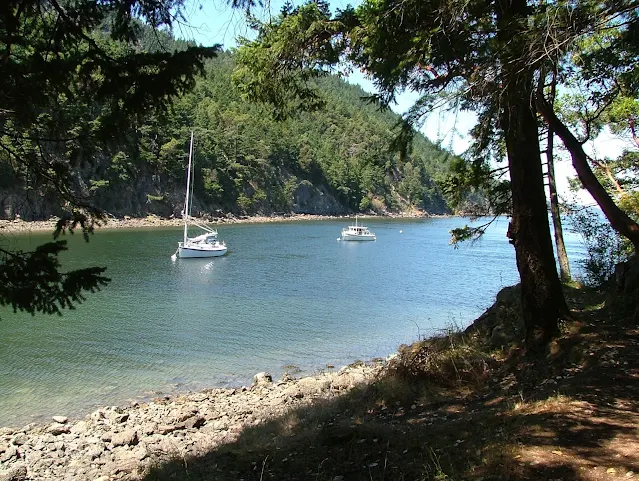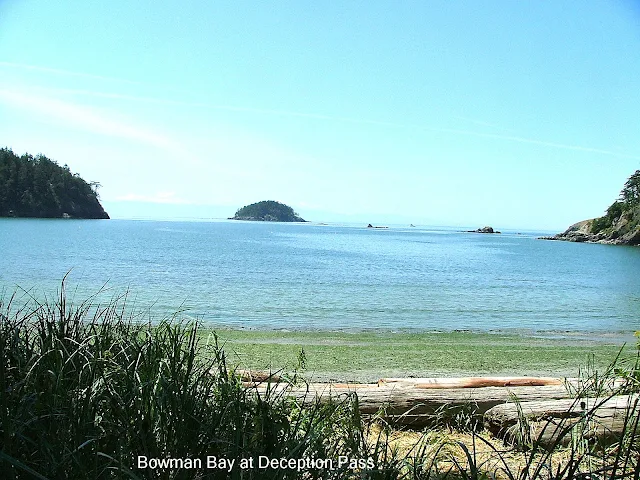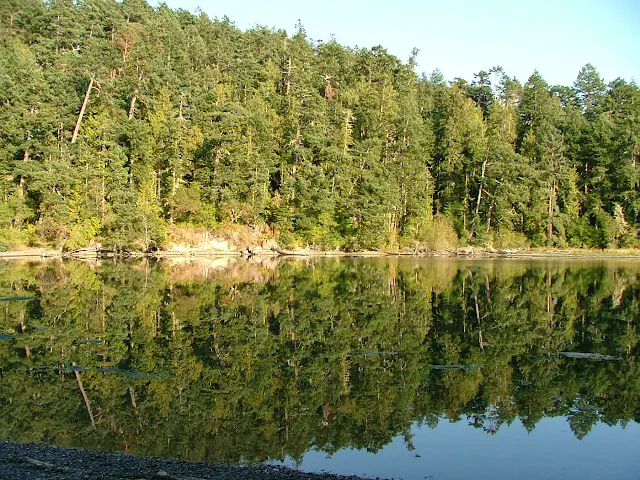Travel Guide, Itineraries, Maps, Charts, Parks and Camping Cruises. Places to go.
Things to do. Pictures, Reviews, Moorages, Marinas, Boat Ramps and Much More.
ATTENTION!
This site has oodles of information about boating and the San Juans, it helps to use the search box BELOW to find what interests you.
Search - "things to do" or try "places to go"
search - Sucia Island
search - Friday Harbor
search - hiking or bicycling
try - kayak - try CAMPING - try Anchoring
++++ ============================= All Posts Below
Current Posts Below
Saturday
Some Foggy Pictures of Rosario Strait and Thatcher Pass in the San Juan Islands
Tuesday
Butchart Garden by Sea
Not part of the San Juan's or even the Gulf Islands, Butchart Gardens should be on everyone's bucket list.
I'll cover some of what I think are important elements for this adventure, but leave your trip planning to you.
- We stayed at Jones Island the night before as our jump off point, but Roche or Stuart are closer. I wanted to be near to our Haro Strait crossing just in case some weather or other issues came up. Nothing did.
- We planned our nine mile 1 1/2 hour crossing of Haro Strait to match up with low wind forecasts and slack tide waters.
- Port of Sidney was our obvious Canada check in place.
- We did have a Canadian chart in our plotter, a larger scale would have been nice but certainly not worth paying for.
- You really should have a dinghy or kayak, but a dinghy motor is not needed to paddle a quarter mile or much less from where you anchor.
- I planned to get to the garden early enough to anchor by 5pm, and then tour on the same day (before dark) and then again after dark.
- Tod Inlet is big, you will have no problem finding a place to anchor.
- Coming back, we carefully listened to the weather report for Haro Strait and took off at 6:30 am the next morning to beat out high winds. We never felt any wind or waves.
- Checking back in at Roche Harbor less than 24 hours after we left was simple and quick.
- It would have been very easy to extend this Canada visit to multiple days and destinations, but we had other plans back in the San Juans, for us this Butchart visit was simply a quick overnight-er. We will be back.
The crossing was a cake walk, we followed our gps pointer straight to Sidney. We had no discernible current set to counter, no swell to deal with. The Port of Sidney customs dock is the first float when you clear the marina breakwater, no other boats were there so we glided in tied up and picked up the phone to check in. Check in took a few minutes, they asked for our names, ages, boat name, and when we were leaving. Oh, and of course they ask about firearms. They give you a long number which you write on a piece of paper and tape to your boat window. That's it, your free to go.
Monday
Did you know you can land your Dinghy at Lopez Village?
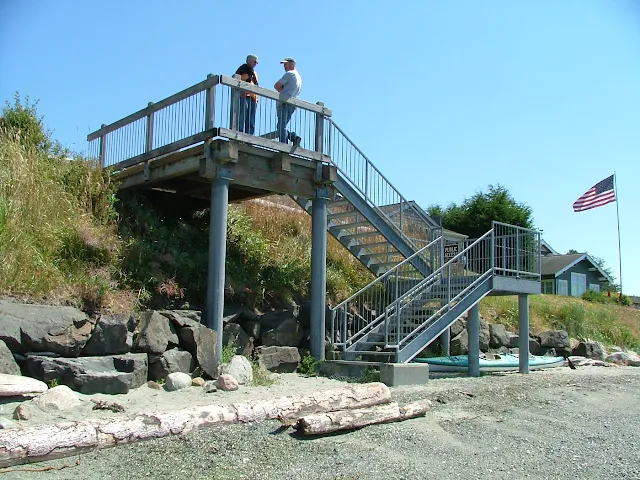 |
| This is the public stairs you will look for from offshore |
This is a google images snapshot of popular Fisherman Bay on Lopez Island. The red dot locates where the public stairs and beach are located. The village is adjacent to the stairs so you can get ice cream and fudge with minimal effort. The grocery store is about a one block walk. Btw, only fifty yards from the stairs is the public restroom with a donations only hot and cold shower. Suggested donation is $2, and there is no timer, now how cool is that?
If you have a navigation chart, you will find the stairs is almost directly opposite the red dolphin nav. aid marking the submerged spit at the bay entrance. (this means you will drive your boat within a couple hundred feet of the stairs, you cant miss em.)
I said there were two access points, the other is south of the red dot about 1-2 blocks, its a low bank off a gravel parking lot with no signs. The stretch between the two accesses is not public beach ( see comments) but I would simply go right to the metal stairway pull my dinghy up and tie it to one of the galvanized legs.
Sunday
This Years Baby Deer Crop in the San Juans is alive and well on Lopez Island
 |
| I came across this little guy while riding around Lopez Island, a minute later it joined up with its twin and trotted off. If you would to see more of the fauna in the San Juan Islands click here >More animals pics |
Jones Island Mooring Buoy Breaks Away
Wow, it almost got us! Well not really but maybe it almost got someone.
We visited Jones one night right after the fourth of July, and we anchored between the park buoys and shore in only ten feet of water. We set our anchor well and tied to shore. During the night it really kicked up, the wind came from the north blowing straight into the cove. We were up at 3 am checking things, it wasn't until mid-morning that things calmed down.
Bid deal you say!
One week later we were back at Jones, and we anchored in exactly the same place, but the park buoy we anchored behind was gone, it was laying, along with a bunch of rusty chain up at the top of the gangplank.
Flashback to the night a week earlier and I remember a rather large yacht tied up in front of us, and we were worried about ourselves dragging onto the beach. No one even considered that a park buoy would give way and set a vessel onto us. BTW at Roche Harbor some years ago a big Bayliner dragged into us so we know first hand how difficult things can get when boats don't stay where you want.
Here's the buoy, The shackle pin is missing. It's hard to see in the picture, but the chain inside the tube is ready to give way also. SURPRISE!
I have suggested before that before leaving an expensive boat tied to one of these things, one should back down on them just like setting your anchor. Hopefully that's what the last visitor did to this one.
It's interesting that the parks dept. installed new pilings and floats at Jones Island but ignored the obvious deteriorated chains.
Much later, I happened to be talking with a ranger and mentioned buoy maintenance and he said they were handled by a different department. Oh well! I'm backing down even harder.
We visited Jones one night right after the fourth of July, and we anchored between the park buoys and shore in only ten feet of water. We set our anchor well and tied to shore. During the night it really kicked up, the wind came from the north blowing straight into the cove. We were up at 3 am checking things, it wasn't until mid-morning that things calmed down.
Bid deal you say!
One week later we were back at Jones, and we anchored in exactly the same place, but the park buoy we anchored behind was gone, it was laying, along with a bunch of rusty chain up at the top of the gangplank.
Flashback to the night a week earlier and I remember a rather large yacht tied up in front of us, and we were worried about ourselves dragging onto the beach. No one even considered that a park buoy would give way and set a vessel onto us. BTW at Roche Harbor some years ago a big Bayliner dragged into us so we know first hand how difficult things can get when boats don't stay where you want.
Here's the buoy, The shackle pin is missing. It's hard to see in the picture, but the chain inside the tube is ready to give way also. SURPRISE!
I have suggested before that before leaving an expensive boat tied to one of these things, one should back down on them just like setting your anchor. Hopefully that's what the last visitor did to this one.
It's interesting that the parks dept. installed new pilings and floats at Jones Island but ignored the obvious deteriorated chains.
Much later, I happened to be talking with a ranger and mentioned buoy maintenance and he said they were handled by a different department. Oh well! I'm backing down even harder.
Thursday
Anchoring at Roche Harbor for the Fourth of July
Arriving at Roche we were not shocked or surprised that the place was really crowded. Being a believer that you can always find room for one more boat, we took a quick tour of the rafting lines and decided to find a place to squeeze in out in the bay. After anchoring and checking out our swing and the swing of those around us I upped anchor and chose another nearby spot, this time very close to shore, but also with a better view. I set two hooks side by side to keep us off the near by rocks should the wind come up. One anchor would have been fine but I slept better for the extra five minutes work.
The fireworks, as promised were very well done, the wind conveniently spun us around so that our cockpit faced the show and the smoke blew away from us. All in all no complaints.
 |
| This pic although lacking something, does convey it was sunset. |
 |
| Our dinghy is the odd one with the cool wood seat and centerboard trunk. |
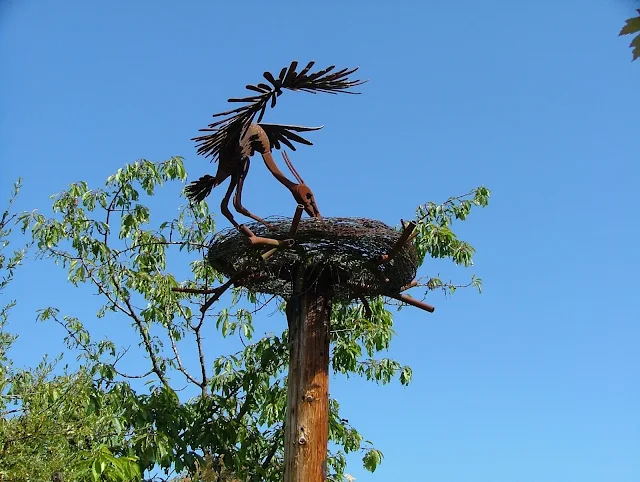 |
| Roche sculpture along foot path by county dock |
 |
| More sculpture |
 |
| No rust, must be stainless steel. |
 |
| Seeing a price tag with a sculpture brings out the art critic and connoisseur, feel free to purchase. |
We finished the cruise with a stop over and hike at Stuart followed by a hot dog roast and windy night anchored at Jones. The next day we ran over to hike and sail Sucia where we spent a rather noisy evening at the dock on Fossil Bay. The fourth day, after a quick hike on Matia, and a drive by of the salmon pens at Deepwater Bay (Cypress), we were back at our slip in La Conner.
This was a pleasant, low key enjoyable little trip of about 110 miles.
(I really like my new laptop gps) read about laptop gps here
BTW, the news Wed. night (three days after arriving back home) was that one of the 85 foot for sale yachts we were all ogling on the fourth burned and sunk at the dock at Roche. It's really shocking (a little scary too) to see news pictures of a yacht you had just admired, and now sunk with just its charred stern above water next to the dock.
Monday
How Long is Your Painter? Does it reach all the way to shore?
You know, that short little rope tied to the front of your dinghy!
Let me explain. When we arrived many hours earlier at a much lower tide, we beached the dinghy and walked away just like so many other times. Knowing the rising tide would float our boat, and we were going for an all day hike I ran my line all the way up to the permanent driftwood pile, above the high water mark. Its true the dinghy will eventually float free and may wash up on shore, but the weather is fine and wakes are frowned upon at Echo Bay.
If I was really worried I could have deployed a light anchor that does not dig in, then when we returned I would have simply hauled it all to shore dragging the anchor with it.
So what, you say?
The point is, when you outfit your shore boat you should anticipate needing a really long rope just in case you need it. My current dinghy has a fifty foot floating line, and if I can't reach something solid, I go find a dog-bone shaped rock and carry it to where I want to tie up. Some skippers carry a small dinghy anchor and rode, then simply carry it up the beach.
Having your dinghy float away doesn't always mean you will lose it forcing you and your crew to swim out to your boat. In popular anchorages someone will probably come to your rescue.
Now this next point is very important. Conditions at the shoreline may change from flat glassy water to two foot waves in just minutes. A far off storm can send waves your way, or a ship may pass by. The resulting pounding waves may flood your dinghy or seriously damage it. With this in mind there will be times and places where you should carry your dinghy up the beach to safety. It is very reassuring knowing your shore boat will be there waiting for you when you return.
This may look like an unpleasant circumstance waiting for our return, but it is exactly what we planned.
Let me explain. When we arrived many hours earlier at a much lower tide, we beached the dinghy and walked away just like so many other times. Knowing the rising tide would float our boat, and we were going for an all day hike I ran my line all the way up to the permanent driftwood pile, above the high water mark. Its true the dinghy will eventually float free and may wash up on shore, but the weather is fine and wakes are frowned upon at Echo Bay.
If I was really worried I could have deployed a light anchor that does not dig in, then when we returned I would have simply hauled it all to shore dragging the anchor with it.
So what, you say?
The point is, when you outfit your shore boat you should anticipate needing a really long rope just in case you need it. My current dinghy has a fifty foot floating line, and if I can't reach something solid, I go find a dog-bone shaped rock and carry it to where I want to tie up. Some skippers carry a small dinghy anchor and rode, then simply carry it up the beach.
Having your dinghy float away doesn't always mean you will lose it forcing you and your crew to swim out to your boat. In popular anchorages someone will probably come to your rescue.
Now this next point is very important. Conditions at the shoreline may change from flat glassy water to two foot waves in just minutes. A far off storm can send waves your way, or a ship may pass by. The resulting pounding waves may flood your dinghy or seriously damage it. With this in mind there will be times and places where you should carry your dinghy up the beach to safety. It is very reassuring knowing your shore boat will be there waiting for you when you return.
Sunday
How to launch at the Port of (fill in name) and the importance of having alternate plans
Never pee into the wind, check.
Never tug on Superman's cape, check.
Never buy a lottery ticket for an investment, check.
Never say never, check, err-unchecked, err.
Never depend on the marina, check, check, and double checked.
In preparation for this seasons cruises I called ahead to the Port of Skagit County in La Conner to arrange for a travel lift launch. Good news I'm told by the very nice lady on the phone, "We have a forklift that lifts 11,000 pounds and we are open until 6:30 pm." Okay great, I'm thinking, we can get there around 3 pm and we only weigh 8500, perfect, oh yeah, how much? "Only $20 or $25 if they have extra work." Fantastic, for only $25 I don't have to dunk my trailer brakes in salt water, this is too good. (and it was)
Reality, or what really happened:
First the ports forklift can only lift 5,000 lbs, and they didn't want to even try. Second they don't have a travel lift, but a light duty overhead tram with a sling, and again they would not try.
My options are -- go away.
Next, at 3 pm we parked on the main drag outside the still open La Conner chamber of commerce where I asked about private boat yards and was supplied with the telephone numbers for two marinas with big travel lifts. A quick phone call determined both businesses were willing to sling my boat for about $125 if I came back tomorrow. I begged for compassionate emergency service, explaining I just drove for six hours depending on the ports promises only to hear, "Do you want to reserve a slot tomorrow, we have customers today." "No thanks," I said.
Plan B, we quickly drove over Rainbow Bridge to Shelter Bay Marina to check out the boat ramp, only to find it high and dry with a falling tide that still had two more hours to go.
Plan C, we quickly drove back over Rainbow Bridge to the La Conner city ramp located almost directly under the bridge. I asked a fisherman fueling his boat out of a tank in the back of his pickup how far the ramp extended. "To the end of the dock," was his answer. Keeping in mind the tide was falling, I went to the far end of the float and with a boat hook began probing six feet down while moving up the ramp. Once many years ago I backed off the end of a ramp dropping the trailer about two feet, then became hung up on the end of the concrete. So, better safe than sorry, now I always probe or somehow determine I will have plenty of ramp.
With about two hours of falling tide water still ahead, a thirty five foot trailer and boat, a thirty foot float with a six foot depth in the middle, fours hours of daylight left, I said lets launch, and began rigging fenders and dock lines while the fisherman finished filling his boat with fuel. When his pickup cleared the single lane ramp I backed down and she floated free. Five minutes later, my rig is locked up and parked in the city provided spaces, and we are on board motoring towards our waiting slip in Shelter Bay.
Total cost - launching and parking, $2.50 per day. Total frustration - not too much.
There is no moral here, my advice as always is, give yourself plenty of time for plans B, C, D....
BTW, I spent a full hour hosing and flushing my trailer with fresh water after retrieving it from the ramp parking lot later that day.
In the fall I will likely reverse the procedure, but try to do it near high tide.
I will probably mention something here unless it is really boring.
Never tug on Superman's cape, check.
Never buy a lottery ticket for an investment, check.
Never say never, check, err-unchecked, err.
Never depend on the marina, check, check, and double checked.
 |
| Rest stop on way to La Conner for launching, and then on to the San Juans |
Reality, or what really happened:
First the ports forklift can only lift 5,000 lbs, and they didn't want to even try. Second they don't have a travel lift, but a light duty overhead tram with a sling, and again they would not try.
My options are -- go away.
Next, at 3 pm we parked on the main drag outside the still open La Conner chamber of commerce where I asked about private boat yards and was supplied with the telephone numbers for two marinas with big travel lifts. A quick phone call determined both businesses were willing to sling my boat for about $125 if I came back tomorrow. I begged for compassionate emergency service, explaining I just drove for six hours depending on the ports promises only to hear, "Do you want to reserve a slot tomorrow, we have customers today." "No thanks," I said.
Plan B, we quickly drove over Rainbow Bridge to Shelter Bay Marina to check out the boat ramp, only to find it high and dry with a falling tide that still had two more hours to go.
Plan C, we quickly drove back over Rainbow Bridge to the La Conner city ramp located almost directly under the bridge. I asked a fisherman fueling his boat out of a tank in the back of his pickup how far the ramp extended. "To the end of the dock," was his answer. Keeping in mind the tide was falling, I went to the far end of the float and with a boat hook began probing six feet down while moving up the ramp. Once many years ago I backed off the end of a ramp dropping the trailer about two feet, then became hung up on the end of the concrete. So, better safe than sorry, now I always probe or somehow determine I will have plenty of ramp.
With about two hours of falling tide water still ahead, a thirty five foot trailer and boat, a thirty foot float with a six foot depth in the middle, fours hours of daylight left, I said lets launch, and began rigging fenders and dock lines while the fisherman finished filling his boat with fuel. When his pickup cleared the single lane ramp I backed down and she floated free. Five minutes later, my rig is locked up and parked in the city provided spaces, and we are on board motoring towards our waiting slip in Shelter Bay.
Total cost - launching and parking, $2.50 per day. Total frustration - not too much.
There is no moral here, my advice as always is, give yourself plenty of time for plans B, C, D....
BTW, I spent a full hour hosing and flushing my trailer with fresh water after retrieving it from the ramp parking lot later that day.
In the fall I will likely reverse the procedure, but try to do it near high tide.
I will probably mention something here unless it is really boring.
Wednesday
Where is Cypress Head Campground and why should you camp there?
I stopped for a quick look around at Cypress Head.
There are quite a few campsites and trail access to all of Cypress Islands trail system.
With a cove on both sides of the head you should be able to find some protection when anchored.
The camping sites at Cypress Head have the best view I have ever seen, but the exposure to wind goes with the view.
There are quite a few campsites and trail access to all of Cypress Islands trail system.
With a cove on both sides of the head you should be able to find some protection when anchored.
The camping sites at Cypress Head have the best view I have ever seen, but the exposure to wind goes with the view.
Saturday
What can boaters do when faced with persistent San Juan Islands fog and Rosario Strait must be crossed
 This is a view down Guemes Channel across four mile wide Rosario Strait at what would be Thatcher Pass if you could see it.
This is a view down Guemes Channel across four mile wide Rosario Strait at what would be Thatcher Pass if you could see it.That wall of white is creeping up the tip of Cypress Island.
You can navigate through the soup and wonder about ferries or turn like that cruiser did, and run around behind Cypress island to cross Rosario over to Peavine or Obstruction Passes. The detour adds only a little bit of time and three miles extra travel, but misses todays fog bank. This is a common situation. Further south at Lopez or Cattle Pass, or Deception it will likely be the same.
Here is a link to a foggy article that may enlighten some > Dealing with fog in the San Juans
Wednesday
Some pictures to Share to make you smile
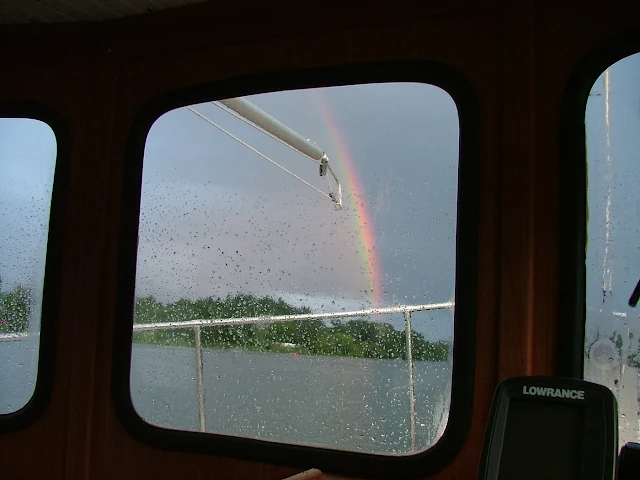 |
| Kind of a miserable day but a bright future |
 |
| left side |
 |
| right side |
 |
| That time of year again More cruising pictures worthy of viewing - click here > Lots of great San Juan images |
Thursday
Does the law require non-swimmers to wear life jackets (pfd) in the San Juan's - No it does not, but some folks on some boats must wear pfd's.
Oh boy, let's argue.
Seriously, you should be conversant with and follow pfd rules, they make sense and save lives. This article is a semi-non serious look at the actual usage on board cruiser vessels.
First of all I'm not trying to make an argument but make a point of different thinking. (just for fun)
Here goes -
If, and I mean if only one life jacket is worn on board, most would say it should be worn by a clumsy non swimmer because they will most likely need it. In this intellectually challenged exercise I suggest that the one and only life jacket should be worn by the most capable person because no one else on board is likely to be able to save him.
The most capable person will have to save himself when no one else is able, hence he should wear the life jacket. Because >> When the most capable person is gone the rest may perish, when the most capable person needs help, who will help him. So with this way of thinking we must preserve the most capable so that the less capable may then be helped.
Was that clear? OK try this scenario -- The skipper gets knocked overboard (crazy crew screws up) and is unconscious in the water without a pfd. By the time the clueless crew can recover (if ever) him/her, its too late. Now the remaining persons on board are at greater risk without the numero uno.
Next scenario --The clumsy helpless crewman trips and goes in the drink without a pfd. The immensely capable skipper springs into action, rescues the klutz in minutes and saves the day.
My backwards conclusion is that in the first scenario the skipper may have survived had he been wearing the only pfd, but the klumsy klutz crew probably would have survived without a pfd due to the skill of the skipper.
What! What is he suggesting, that the skipper gets the only pfd? Outrageous! Blasphemy! What about the Master's responsibility to ship, crew and passengers - Keel haul the laggardly sot.
On a serious note:
Look around the docks where all the boats are coming and going and you invariably see the women and children (even pooches) bundled up in the latest good looking approved flotation apparel. Makes sense, right? - save the hapless and helpless from succumbing to a maritime accident lurking around the next slip or piling. Look closely and many times you see the person stepping (we never jump do we) from boat to dock or dock to boat, handling lines, pushing off, keeping track of passengers, other boats, etc, etc, is not wearing a pfd. All the passengers that are seated and doing nothing are properly belted in, but the one person really in harm's way, the one person all others depend on, the one person the others may not be able to save - is not wearing a pfd at all.
I need to end this tirade by saying that simply having pfd's on board may keep the regulators happy but won't help the unfortunate skipper over the side, while his helpless family watches him struggle.
There are certain times (docking-working on deck) when all crew and skipper should be wearing safety gear - and that is just good seamanship.
Sobering thought!
Seriously, you should be conversant with and follow pfd rules, they make sense and save lives. This article is a semi-non serious look at the actual usage on board cruiser vessels.
First of all I'm not trying to make an argument but make a point of different thinking. (just for fun)
Here goes -
If, and I mean if only one life jacket is worn on board, most would say it should be worn by a clumsy non swimmer because they will most likely need it. In this intellectually challenged exercise I suggest that the one and only life jacket should be worn by the most capable person because no one else on board is likely to be able to save him.
The most capable person will have to save himself when no one else is able, hence he should wear the life jacket. Because >> When the most capable person is gone the rest may perish, when the most capable person needs help, who will help him. So with this way of thinking we must preserve the most capable so that the less capable may then be helped.
Was that clear? OK try this scenario -- The skipper gets knocked overboard (crazy crew screws up) and is unconscious in the water without a pfd. By the time the clueless crew can recover (if ever) him/her, its too late. Now the remaining persons on board are at greater risk without the numero uno.
Next scenario --The clumsy helpless crewman trips and goes in the drink without a pfd. The immensely capable skipper springs into action, rescues the klutz in minutes and saves the day.
My backwards conclusion is that in the first scenario the skipper may have survived had he been wearing the only pfd, but the klumsy klutz crew probably would have survived without a pfd due to the skill of the skipper.
What! What is he suggesting, that the skipper gets the only pfd? Outrageous! Blasphemy! What about the Master's responsibility to ship, crew and passengers - Keel haul the laggardly sot.
On a serious note:
Look around the docks where all the boats are coming and going and you invariably see the women and children (even pooches) bundled up in the latest good looking approved flotation apparel. Makes sense, right? - save the hapless and helpless from succumbing to a maritime accident lurking around the next slip or piling. Look closely and many times you see the person stepping (we never jump do we) from boat to dock or dock to boat, handling lines, pushing off, keeping track of passengers, other boats, etc, etc, is not wearing a pfd. All the passengers that are seated and doing nothing are properly belted in, but the one person really in harm's way, the one person all others depend on, the one person the others may not be able to save - is not wearing a pfd at all.
I need to end this tirade by saying that simply having pfd's on board may keep the regulators happy but won't help the unfortunate skipper over the side, while his helpless family watches him struggle.
There are certain times (docking-working on deck) when all crew and skipper should be wearing safety gear - and that is just good seamanship.
Sobering thought!
Monday
How many Anchors do you need for cruising in the San Juan Islands when Visiting the Marine Parks
One anchor!
Two!
More?
The quick and easy answer is, "you need the same amount anywhere you go"
No help so far, Okay lets talk a scenario that could be any of us.
You arrive at your first nights anchorage, a quiet little protected bay with a rocky bottom.
What a great vacation, hot dogs over a campfire onshore, some wine or beer, a really restful nights sleep, rich coffee in the morning, and then when you try to raise the anchor your hooked to the biggest rock in the world. after hours of pulling from all directions you finally give up and cut the line, ouch, 250 bucks worth of anchor and rode, gone. Oh well, your not going to let a lost anchor spoil a perfect vacation and off you go to the next idyllic spot in the San Juan's.
Now it really hits home, the dock is full, no one offers to or wants to raft your boat. So you think, that's okay, I'll just go ashore in the dinghy find an anchor shaped rock, bring it back to the mother ship, and tie it to whats left of the cut rode. Except the rode is too short, and you need to stay on board to keep circling in the boat because no one in your crew (wife and children) is qualified to run the boat while your rock hunting. So your current ex-spouse rows to shore, and .... see where this is going?
What should happen is you break out a spare anchor and rode that's stored and ready to deploy once you tie off the bitter end. Your admiring first spouse and children think you're a hero.
OK, dinghy scenario. Your youngest children that have just mastered rowing are off somewhere nearby while you snooze or read a book. Little do you know but they just lost both oars and the wind is quickly
Click below to read more
Two!
More?
The quick and easy answer is, "you need the same amount anywhere you go"
No help so far, Okay lets talk a scenario that could be any of us.
You arrive at your first nights anchorage, a quiet little protected bay with a rocky bottom.
What a great vacation, hot dogs over a campfire onshore, some wine or beer, a really restful nights sleep, rich coffee in the morning, and then when you try to raise the anchor your hooked to the biggest rock in the world. after hours of pulling from all directions you finally give up and cut the line, ouch, 250 bucks worth of anchor and rode, gone. Oh well, your not going to let a lost anchor spoil a perfect vacation and off you go to the next idyllic spot in the San Juan's.
Now it really hits home, the dock is full, no one offers to or wants to raft your boat. So you think, that's okay, I'll just go ashore in the dinghy find an anchor shaped rock, bring it back to the mother ship, and tie it to whats left of the cut rode. Except the rode is too short, and you need to stay on board to keep circling in the boat because no one in your crew (wife and children) is qualified to run the boat while your rock hunting. So your current ex-spouse rows to shore, and .... see where this is going?
What should happen is you break out a spare anchor and rode that's stored and ready to deploy once you tie off the bitter end. Your admiring first spouse and children think you're a hero.
OK, dinghy scenario. Your youngest children that have just mastered rowing are off somewhere nearby while you snooze or read a book. Little do you know but they just lost both oars and the wind is quickly
Click below to read more
Solo Circumnavigation Under Sail Without an Engine No Less
It's true, I have joined the ranks of solo sailors, except before my head gets too swelled I must admit I simply sailed around Coon Island. But I did do it solo, and I didn't bring a motor.
When I cast off that melancholy mid morning, right after breakfast, heading southerly, I was immediately faced with a 1.5 mph adverse current that began to drag me backwards. Thankfully my 30 year old, new to me, 9.5' sailing dinghy performed well in the light airs easily overcoming the current. Soon I was past the point of no return, rounding the tip of Coon Island, being careful to avoid the sunken breakwater barge. Once around the point my trusty vessel was caught in a spinning vortex that would terrify a less experienced sailor. The tiller became unresponsive as we spun through several 360 degree turns. In desperation, and trying not get hit in the head, I used my free hand to tame the boom and back wind the mainsail. Finally free of the barges eddy's, we were off on three or four rail down tacks making quick work of the island's west side.
Only a few minutes after eating and with no food or water on board, I was approaching what would become the final turn and then a telling downwind romp back to the dock I had left 1,500+- seconds earlier. Letting out the main sheet, and slacking the out-haul there was nothing left to do but bask in well deserved glory as I approached the dock from the opposite direction I had departed from less than half an hour earlier that morning.
After handing the dock line to an admiring power boater, I was greeted warmly with, "I see your problem, you have a loose nut on the end of your tiller."
 |
| One of two Coon Island floats, on shore are composting toilets, shelter, fire rings, and a few campsites. |
Coon Island is in the Multnomah Channel, a side shoot off the Columbia River. The entire half mile long 23 acre island is a county park, (JJ Collins Marine Park) and my favorite place to overnight near my home in Portland.
Now that I have become infected with the circumnavigation bug I am setting my sights on bigger and more challenging goals. This summer in the San Juans I will attempt Jones Island on July 5th, but I'm not promising any biggies such as Sucia, and of course Orcas is just a dream for my 9.5 sailing dinghy. ( maybe for Orcas, I'll bring my 2.5 hp Suzuki kicker, and a sandwich)
Tuesday
What is "Current Set" - The San Juan's and Puget Sound are full of potential Catastrophes - Ignornace is Bliss
Is it really a close call if you don't know about it? If a catastrophe almost happens, is it worthy to note?
When your boat is drifting towards a lee shore, but still has two hours before running onto the rocks is it a big deal?
Ignorance really is bliss, that's for sure.
I don't know how many times I have almost sunk, no one does, like Donald Rumsfeld once said, "We don't know what we don't know."
I know this though -- one time crossing Rosario Strait heading into Thatcher Pass, we were all staring out the front and not paying attention to our sideways set (side drift) when out of the corner of my eye I caught a movement that turned out to be rocks coming at us fast. (full flood must have been 3+ knots) The current was forcing us sideways straight onto the rocks of tiny Pointer Island. I swung hard over and pushed her to full throttle, our outboard barely pulled us away with one hundred feet and two or three seconds to spare. I shuddered thinking of my family on board and almost quit boating right then and there.
Another time, just after leaving Sidney Spit to cross Haro Strait, when suddenly out of the dense fog loomed the green aid marking Mandarte Island. Once again I had not paid enough attention to the current set and was almost swept onto the rocks.
And again, once we ran out of gas in the "Narrows" and the current quickly whisked us towards an anchored construction barge under the new Tacoma Bridge. Quick action switching tanks averted an unpleasant incident with just minutes to spare.
So, I have admitted to three times that I know of, where my inattention to currents has almost had disastrous results. How many more are there that I don't know about, I don't know.
My problem is, I tend to watch where the boat is pointed or where I want to go and not where we are really going.
Ignorance is bliss, but is no way to skipper a boat.
When your boat is drifting towards a lee shore, but still has two hours before running onto the rocks is it a big deal?
Ignorance really is bliss, that's for sure.
I don't know how many times I have almost sunk, no one does, like Donald Rumsfeld once said, "We don't know what we don't know."
I know this though -- one time crossing Rosario Strait heading into Thatcher Pass, we were all staring out the front and not paying attention to our sideways set (side drift) when out of the corner of my eye I caught a movement that turned out to be rocks coming at us fast. (full flood must have been 3+ knots) The current was forcing us sideways straight onto the rocks of tiny Pointer Island. I swung hard over and pushed her to full throttle, our outboard barely pulled us away with one hundred feet and two or three seconds to spare. I shuddered thinking of my family on board and almost quit boating right then and there.
Another time, just after leaving Sidney Spit to cross Haro Strait, when suddenly out of the dense fog loomed the green aid marking Mandarte Island. Once again I had not paid enough attention to the current set and was almost swept onto the rocks.
And again, once we ran out of gas in the "Narrows" and the current quickly whisked us towards an anchored construction barge under the new Tacoma Bridge. Quick action switching tanks averted an unpleasant incident with just minutes to spare.
So, I have admitted to three times that I know of, where my inattention to currents has almost had disastrous results. How many more are there that I don't know about, I don't know.
My problem is, I tend to watch where the boat is pointed or where I want to go and not where we are really going.
Ignorance is bliss, but is no way to skipper a boat.
 |
| You wouldn't cross in front of a ship making 6 knots, so why pass barely upstream of rocks in a 6 knot current? |
Saturday
Roche Harbor 4th of July reservations at the Marina
I called the Roche Harbor Master today to see if a slip was open for the 4th of July
The answer was NO.
I was told they hold a lottery in February and I missed it, rats. Looks like I'll be anchoring out this year.
Just thought I would pass this along.
btw this was 2013
John
The answer was NO.
I was told they hold a lottery in February and I missed it, rats. Looks like I'll be anchoring out this year.
Just thought I would pass this along.
btw this was 2013
John
Wednesday
Traveling to Butchart Gardens by Boat - Itinerary - Canada/USA Customs - Anchor in Tod Inlet
For us, one of the best parts about cruising the San Juan's is not having to make any reservations or depend on anyone else. After a quick stop at the store for food, we just go, and then let the relaxing begin the moment we cast off. Four days, five days, ten days, I quickly leave everything behind, (including the wine and Hershey bars by mistake) all my thoughts are of traveling and carefree times.
However, many times my plans are waylaid by life's little curves and family events. Life curves that I have little control over, and family that - well that just takes precedence over my cruise plans.
Case in point, it took me four years and three tries to finally see in person the flag lowering ceremony held each balmy summer evening at Roche Harbor. One time I missed the cruise altogether, and another time a boat dragged anchor into us just minutes before the cannon went off. When I did get to witness the entire show it was just by happenstance that we were there, for I had given up and mostly forgot about the cannon firing sundown ritual. So when this baby replica of a middle age artillery piece blasted a hole in my thoughts, and its muzzle flash lit up the manicured lawn, I was taken by surprise to say the least. Oh I may have yelled or screamed just a little but no one heard me. The blast was not really deafening but very loud never the less, took me by surprise and captured everyone's attention. Then the returning echoes bouncing off Henry Island from across Roche Harbor drowned out all evidence of my heavy breathing and rapid heart beat. What did he just babble? (how to relax?)
click below to read about Butchart Gardens!
Friday
Where is this place? and what is it?
Hint, its in the San Juans (of course)
48* 47. 337' N (how do you make that little degree circle thingy")
122* 58. 277' W
(anyone can figure this out, but can you do it in under 60 seconds? five minutes?)
48* 47. 337' N (how do you make that little degree circle thingy")
122* 58. 277' W
(anyone can figure this out, but can you do it in under 60 seconds? five minutes?)
Thursday
What is the Cheapest Chart Plotter Available - My new laptop GPS is awesome and not expensive
Not too long ago I posted that I needed a new gps, but couldn't remember why I needed a new one. Sound familiar!
(update) I remember now, the curser quits moving while it redraws charts and sometimes it takes awhile to catch up, so its not really broken just too slow.
Anyway I've been shopping gps units and have been shocked and irritated at the manufacturers high prices and total arrogance.
This is the way I see it!
- They sell us a product that does the same thing a highway unit does (mostly) for ten times the price.
- They then make us buy maps separately because the pre-loaded chart shows the shoreline as a straight line, and small islands are skipped completely.
- Then to top it off they quit supporting (selling chips) for older units forcing us to buy all new stuff, and start all over again.
- And the stuff they make us buy are all in one units called mfd's (multifunctiondisplays) as if giving it a fancy name makes it a good idea. Well most of us have tripped and broken a few eggs and when they are all in one basket, you know what happens. If that was too to hard grasp, it means they all broke. It means when your mfd quits, you have lost your gps, your sounder, maybe your compass, certainly your chart. Why buy a paper chart when you have a $5,000 chart plotter. oh yeah your knot meter too, but who cares how fast your going when your lost. Did I mention radar, yeah for another 5k+ you can get it in the same basket.
- They're laughing all the way to the bank while we just gobble up their over priced products.
And this is what I did:
- I bought a gps antenna (usb) and chart plotter program for my laptop, total cost $99. Of course I already had a $350 lap top with a 15 inch screen BTW. (awesome detail)
- it came with a dvd with every NOAA chart published
- every chart is the most recent updated published
- it works great and has all the detail the others choose to spoon feed us $350 at a time because NOAA is where the charts come from in the first place.
- as a bonus I got chart number one (free online anyway) just a click away as well as tide prediction, coast pilot, all part of a full feature chart plotter navigation suite.
- and even better I have a copy loaded onto my home computer with a 27 inch screen so I can cruise around when I'm not on the boat.
- and if it quits, I can send it back to Dell (the lap top) or pick up a new one and load the program on as many computers as I want
Now here's the down side: (none) okay, it is not 3D.
- I still need a separate sounder. (have two, that's a good thing)
- and a stand alone compass. (got it) another good thing
- I'm afraid I will be keeping my charts handy in case my laptop screen goes blue or battery's go dead.
- redraw times are instantaneous, darn.
- I still plan to keep my handheld, ( you know, eggs in a basket and all).
- I'm worried someone will break into my boat thinking I have a fancy chart plotter hidden away.
- I wont have any discontinued phone numbers for shore side businesses in my expensive discontinued chart plotter.
- I'm sure there must be more negatives.
- OK, here's one, my lap top is not designed for salt water use. Hmmm? you know it cost $350, and that's not counting converting to boating units. (I think the boat unit conversion is multiply 7X, or is it 10X.)
Installation was a snap:
Just plug in the usb antenna and set on ledge by window, open laptop and power up.
In about five seconds the red menu box turns black meaning satellites are detected and locked on.
One last point:
It works while in the car, but there are no detailed highway maps, only main highways on charts. I guess NOAA figures boats will stay in the water.
I am really excited about this new toy (I mean tool)(nav aid)(gps)(chart plotter)
$99 chart plotter, that's less boat bucks than, than, than, well its less than anything I can think of except an led bulb I just bought for $ 8 plus shipping.
I think you can download the sea clear program for free if you're techie prone. (I bought what someone had put on a disk)
 |
| This is the pixlated logo for the Sea Clear program |
http://www.sping.com/seaclear/
Saturday
Radio Use - call letters for fun and amusement
Just for fun I've copied some of those letters and words the experts use. You know the ones we can hear really clear so they don't need to spell it out, but do it anyway!
BTW Sailing the San Juans is alive and well but it's January and 22 degrees outside right now.
PHONETIC TABLES
For the pronunciation of letters
and figures by radiotelephony or by voice over a loud hailer.
LETTER SPELLING
TABLE
Letter Code Word
Pronunciation
A Alfa AL FAH
B Bravo BRAH VOH
C Charlie CHAR LEE
(or SHAR LEE)
D Delta DELL TAH
E Echo ECK OH
F Foxtrot FOKS TROT
G Golf GOLF
H Hotel HOH TELL
I India IN DEE
AH
J Juliett JEW LEE
ETT
K Kilo KEY LOH
L Lima LEE MAH
M Mike MIKE
N November NO VEM
BER
O Oscar OSS CAH
P Papa PAH PAH
Q Quebec KEH BECK
R Romeo ROW ME
OH
S Sierra SEE AIR
RAH
T Tango TANG GO
U Uniform YOU NEE
FORM (or OO NEE FORM)
V Victor VIK TAH
W Whiskey WISS KEY
X X-ray ECKS RAY
Y Yankee YANG KEY
Z Zulu ZOO LOO
Note: The Boldfaced
syllables are emphasized.
Sunday
What Does Stuart Island Have to Offer the Boating Traveler?
If you can find the time to visit Roche Harbor then you can certainly pop over to Stuart.
Click on the link below then scroll way, way - way, way, down to Stuart Island for details, chart and photos of Stuart Island
Take this link to the parks page
- bicycle Stuart
- camp on shore
- camp, anchor or tie to dock at Reid Harbor
- camp, anchor or tie to dock at Prevost Harbor
- use the county dock
- hike to Turn Point Lighthouse and visit the museum
- visit two pioneer school houses
- buy Boundary Pass Traders T-shirts
- orca watch
Click on the link below then scroll way, way - way, way, down to Stuart Island for details, chart and photos of Stuart Island
Take this link to the parks page
Bowman Bay, Sharpe Cove, and Rosario Beach at Deception Pass State Park are not a - drive by- dock on the way to the San Juan Islands
Lots of boaters know where Bowman Bay is located but just go right on by without stopping. It's an easy place to skip because you're always on your way to somewhere, somewhere else. Most of the time for us we're heading through Deception Pass and then onto the San Juan's or going the other way with La Conner, or Puget Sound in mind. With this knowledge we decided to make Bowman Bay our primary destination. We would spend a night or two, explore the anchorage areas, hike the trails, have a campfire if possible and see what the place has to offer.
For starters it offers Deception Pass with fantastic scenery as your constant backdrop, how can you go wrong? On this mini cruise we timed our arrival at the pass so that we would not encounter opposing current and have a window all afternoon to make it through. Our partially disabled boat pushed by an outboard (get-er-home kicker) had a top speed of 5 mph, so once committed to shooting the gap so to speak, we knew we weren't coming back, at least not for awhile.
Bowman Bay is part of Deception Pass State Park. It's on the outside of the pass, on the north side of the bridge, so this means it is subject to the whims and tantrums of the Strait of Juan De Fuca. To clarify -- fog, waves and swells may be part of the cruise, but on our visit, flat waters and lots of balmy sunshine were the order of the day.
The bay really consists of two distinct areas, the further in more protected waters are opposite the campground and offer a half dozen or so anchor buoys just a dinghy ride from shore.
At the other end of the bay is a nice but smallish float hidden and protected by a little hook of a point. (Sharpe Cove) We chose the float so we could easily access the park bathrooms and walk to the beach for a campfire. To make room and keep our 5 1/2 foot keel out of the mud we tied up with half the boat hanging out past the end of the dock.
From our float location we walked all the way to the other end of the bay and out onto a grassy knoll called Lighthouse Point, (there is no lighthouse, but there is a flashing green, 4s nav aid) for a fantastic view of Deception Pass and the bridge. The hike took several hours and we were suitably tired afterwards but this was by no means a tough or experts only hike. The only comment I want to offer is be sure to give yourself enough time to enjoy, explore, and get back before dark. There are a few spots you don't want to try without a flashlight if it gets dark on you.
In the morning after a leisurely coffee and stroll exploring the tide pools on the Rosario Beach side of the point, Linda contemplates, what I don't know. The tide was rising and the current at the pass would be flowing inward for several hours. We reluctantly cast off and steered into the current. In minutes we were under the bridge and on our way to our slip at Shelter Bay in La Conner, and then home. Bowman Bay is no longer that place we just fly by on our way to somewhere else.
 |
| This tiny spit protects and marks the far end of Bowman Bay although on the chart it's listed as Sharpe cove. |
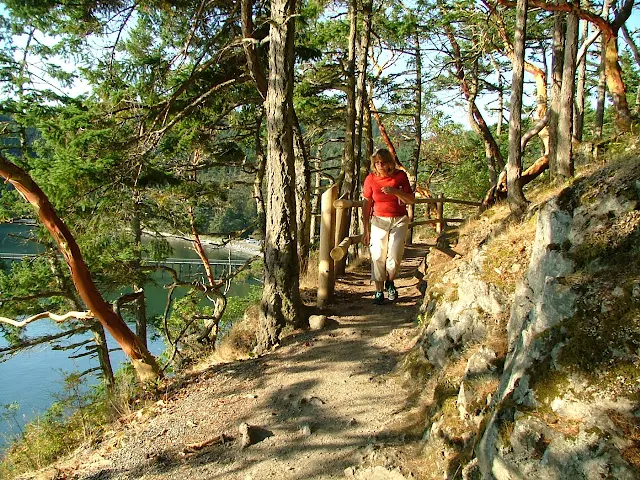 |
| The trail runs along the shore for all of Bowman Bay, or you may hike up to the bridge and beyond to explore the rest of Deception Pass Park |
Bowman Bay is part of Deception Pass State Park. It's on the outside of the pass, on the north side of the bridge, so this means it is subject to the whims and tantrums of the Strait of Juan De Fuca. To clarify -- fog, waves and swells may be part of the cruise, but on our visit, flat waters and lots of balmy sunshine were the order of the day.
The bay really consists of two distinct areas, the further in more protected waters are opposite the campground and offer a half dozen or so anchor buoys just a dinghy ride from shore.
At the other end of the bay is a nice but smallish float hidden and protected by a little hook of a point. (Sharpe Cove) We chose the float so we could easily access the park bathrooms and walk to the beach for a campfire. To make room and keep our 5 1/2 foot keel out of the mud we tied up with half the boat hanging out past the end of the dock.
From our float location we walked all the way to the other end of the bay and out onto a grassy knoll called Lighthouse Point, (there is no lighthouse, but there is a flashing green, 4s nav aid) for a fantastic view of Deception Pass and the bridge. The hike took several hours and we were suitably tired afterwards but this was by no means a tough or experts only hike. The only comment I want to offer is be sure to give yourself enough time to enjoy, explore, and get back before dark. There are a few spots you don't want to try without a flashlight if it gets dark on you.
 |
| The wharf is for walking only, no boats may tie up. Anchor buoys are beyond wharf, campground is to right. |
 |
| On a clear day you would see Vancouver Island, but this wasn't bad. |
Friday
Submarines have right of way! And the Coast Guard the Navy and anyone with big guns
They got lots of guns around them too. woohoo!
Cutting across the entrance to Hood Canal on our way to Port Ludlow we were suddenly stopped by Coast Guard and Navy patrol boats. They were all business insisting we stop and wait, the submarine soon came by at about 10 knots, all the the while they kept the patrol boat between us and the sub as if we may be a threat. (or they were camera shy)
The sub had 12 to 15 boats running interference for it as it headed out. All done very efficiently.
BTW afterwards from somewhere we got hit with a big big wake.
Crossing paths with a submarine was an unexpected treat. The next day we cruised up Hood Canal past the Navy base but failed to see anything worth reporting except maybe a huge sign saying lethal force authorized. We kept our distance.
Cutting across the entrance to Hood Canal on our way to Port Ludlow we were suddenly stopped by Coast Guard and Navy patrol boats. They were all business insisting we stop and wait, the submarine soon came by at about 10 knots, all the the while they kept the patrol boat between us and the sub as if we may be a threat. (or they were camera shy)
The sub had 12 to 15 boats running interference for it as it headed out. All done very efficiently.
BTW afterwards from somewhere we got hit with a big big wake.
Crossing paths with a submarine was an unexpected treat. The next day we cruised up Hood Canal past the Navy base but failed to see anything worth reporting except maybe a huge sign saying lethal force authorized. We kept our distance.
Saturday
VHF Marine Radio Etiquette Rules to follow and how to entertain other boaters
We talked about radio use before, but lets do it again because some of us need to lighten up.
Some of us when calling (hailing) our good buddy's say the boat name they are calling (usually some descriptive name like "barfing good times for all" or "I think I heard enough already" or this true one "om pa pa - om pa pa" try listening to that three times ) three or four times in a row, and if that's not tedious enough they say it clearly, plainly, slowly, enounciatingly, pronounciatingly, excruciatingly perfect. Enough already again, just say it once, normally -- are you in love with saying the boats name or something? Besides you just talked to them five minutes ago, why should all of us have to listen to your ten minute hailing speech again. And then, all you have to say is something like, "Hey Joe, do you want french or thousand Island dressing?"
Now I know its proper to repeat three times when hailing -- but give it a break.
Here are some pet peeves and tongue in cheek ideas:
Some of us when calling (hailing) our good buddy's say the boat name they are calling (usually some descriptive name like "barfing good times for all" or "I think I heard enough already" or this true one "om pa pa - om pa pa" try listening to that three times ) three or four times in a row, and if that's not tedious enough they say it clearly, plainly, slowly, enounciatingly, pronounciatingly, excruciatingly perfect. Enough already again, just say it once, normally -- are you in love with saying the boats name or something? Besides you just talked to them five minutes ago, why should all of us have to listen to your ten minute hailing speech again. And then, all you have to say is something like, "Hey Joe, do you want french or thousand Island dressing?"
Now I know its proper to repeat three times when hailing -- but give it a break.
Here are some pet peeves and tongue in cheek ideas:
- Is your radio set on low power when you call Joe, no one in the next state wants to hear you.
- How about staying on 68 or 69, 71,72, if you're going to keep calling every five minutes.
- If they don't respond, wait awhile longer than thirty seconds before trying again, unless the world is ending it wont matter.
- Try using your cell phone.
- If your making us all listen to your party plans, how about an open invitation.
- Sticky mikes happen a lot, check yours if your not hearing anything. The easiest way is with another radio. (call for a radio check)
- Just say the name once--pleeease, unless it really does sound better to repeat repeat
Okay, I've cooled off some, ranting can be therapy, let's continue.
- Transmit on low power unless, a mayday call (radios have a high/low switch).
- Hail on channel 16 and then agree to switch to 68,69 or others for chit chat.
- Keep your chit chat short, others are waiting and we only have a few channels for recreational use.
- Btw, radio use (all channels) is supposed to be for operational purposes not chit chat and exchanging dinner recipes. This rule is widely ignored,
- Btw, did you know your required to monitor 16 if you have a radio?
- Be polite and concise, then get off.
- Hold the mike close but don't yell.
- You can say over but you dont need to, most know when its over.
- Over.
- Roger.
- Roger dodger.
- Standing by on 16, 69, pins and needles.
I'm good, I'm done.
Subscribe to:
Posts (Atom)


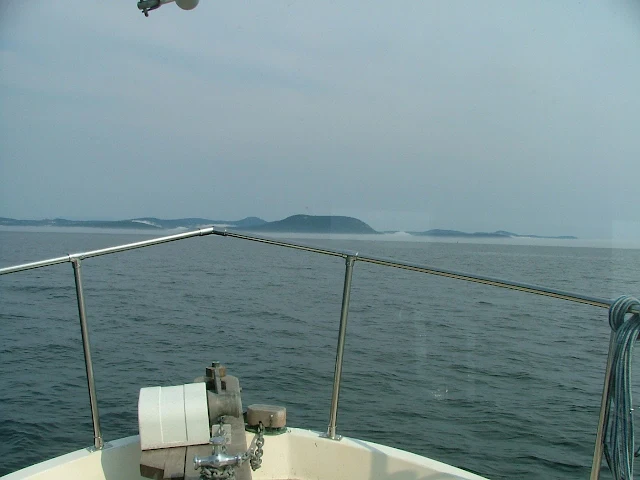
.JPG)
